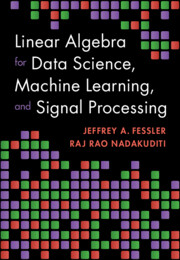Refine search
Actions for selected content:
6829 results in Communications and signal processing
Index
-
- Book:
- Channel Codes
- Published online:
- 06 March 2025
- Print publication:
- 21 November 2024, pp 758-763
-
- Chapter
- Export citation
Acknowledgments (First Edition)
-
- Book:
- Channel Codes
- Published online:
- 06 March 2025
- Print publication:
- 21 November 2024, pp xxvi-xxvi
-
- Chapter
- Export citation

Linear Algebra for Data Science, Machine Learning, and Signal Processing
-
- Published online:
- 01 November 2024
- Print publication:
- 16 May 2024
-
- Textbook
- Export citation
9 - Orthogonal Frequency-Division Multiplexing
-
- Book:
- Digital Communications
- Published online:
- 22 November 2024
- Print publication:
- 31 October 2024, pp 344-385
-
- Chapter
- Export citation
5 - State Equivalence, State Reduction
- from Part I - Lectures on Basics with Examples
-
- Book:
- Time-Variant and Quasi-separable Systems
- Published online:
- 24 October 2024
- Print publication:
- 31 October 2024, pp 73-86
-
- Chapter
- Export citation
9 - The Kalman Filter as an Application
- from Part I - Lectures on Basics with Examples
-
- Book:
- Time-Variant and Quasi-separable Systems
- Published online:
- 24 October 2024
- Print publication:
- 31 October 2024, pp 136-153
-
- Chapter
- Export citation
7 - Inner Operators and External Factorizations
- from Part I - Lectures on Basics with Examples
-
- Book:
- Time-Variant and Quasi-separable Systems
- Published online:
- 24 October 2024
- Print publication:
- 31 October 2024, pp 95-114
-
- Chapter
- Export citation
2 - Equivalent Complex Baseband Signals
-
- Book:
- Digital Communications
- Published online:
- 22 November 2024
- Print publication:
- 31 October 2024, pp 26-53
-
- Chapter
- Export citation
3 - LTV (Quasi-separable) Systems
- from Part I - Lectures on Basics with Examples
-
- Book:
- Time-Variant and Quasi-separable Systems
- Published online:
- 24 October 2024
- Print publication:
- 31 October 2024, pp 41-58
-
- Chapter
- Export citation
Appendix B - Short Introduction to Channel Coding
-
- Book:
- Digital Communications
- Published online:
- 22 November 2024
- Print publication:
- 31 October 2024, pp 419-453
-
- Chapter
- Export citation
Index
-
- Book:
- Time-Variant and Quasi-separable Systems
- Published online:
- 24 October 2024
- Print publication:
- 31 October 2024, pp 304-306
-
- Chapter
- Export citation
Frontmatter
-
- Book:
- Time-Variant and Quasi-separable Systems
- Published online:
- 24 October 2024
- Print publication:
- 31 October 2024, pp i-iv
-
- Chapter
- Export citation
Appendix D - Time-Invariant and Time-Varying Channel Models
-
- Book:
- Digital Communications
- Published online:
- 22 November 2024
- Print publication:
- 31 October 2024, pp 468-486
-
- Chapter
- Export citation
4 - System Identification
- from Part I - Lectures on Basics with Examples
-
- Book:
- Time-Variant and Quasi-separable Systems
- Published online:
- 24 October 2024
- Print publication:
- 31 October 2024, pp 59-72
-
- Chapter
- Export citation
2 - Dynamical Systems
- from Part I - Lectures on Basics with Examples
-
- Book:
- Time-Variant and Quasi-separable Systems
- Published online:
- 24 October 2024
- Print publication:
- 31 October 2024, pp 21-40
-
- Chapter
- Export citation
7 - Digital Frequency and Phase Modulation
-
- Book:
- Digital Communications
- Published online:
- 22 November 2024
- Print publication:
- 31 October 2024, pp 247-286
-
- Chapter
- Export citation
11 - Quasi-separable Moore−Penrose Inversion
- from Part I - Lectures on Basics with Examples
-
- Book:
- Time-Variant and Quasi-separable Systems
- Published online:
- 24 October 2024
- Print publication:
- 31 October 2024, pp 169-182
-
- Chapter
- Export citation
Copyright page
-
- Book:
- Digital Communications
- Published online:
- 22 November 2024
- Print publication:
- 31 October 2024, pp iv-iv
-
- Chapter
- Export citation
1 - Introduction
-
- Book:
- Digital Communications
- Published online:
- 22 November 2024
- Print publication:
- 31 October 2024, pp 1-25
-
- Chapter
- Export citation
12 - LU (Spectral) Factorization
- from Part II - Further Contributions to Matrix Theory
-
- Book:
- Time-Variant and Quasi-separable Systems
- Published online:
- 24 October 2024
- Print publication:
- 31 October 2024, pp 185-201
-
- Chapter
- Export citation
